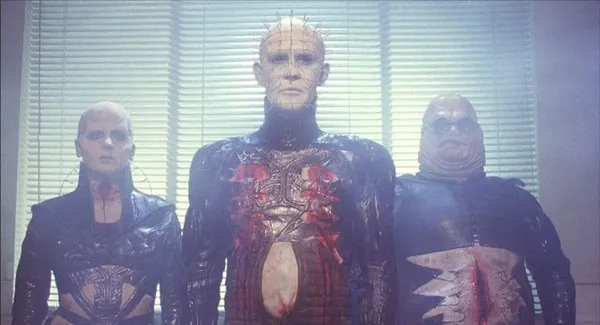Eye For Film >> Movies >> Hellraiser (1987) Film Review
Hellraiser
Reviewed by: Jennie Kermode

Hellraiser is one of those films which has become a victim of its own success. So influential was it in its time that it spawned decades' worth of imitations, and it's difficult for modern audiences to appreciate how much of what it does was new at the time. It pushed boundaries with its special effects, its gore content and its themes, but also with its casting, giving the central role to a 32-year-old woman previously known only for her work in TV mini series. Clive Barker was always at his strongest as a creator of characters and this is a role many actresses would kill for.
Despite what its credits suggest, this is a film that belongs to Clare Higgins. She's in almost every scene, trapped by the camera the way her character, Julia, is trapped in the house where her lover Frank died. His brother, her husband Larry (Andrew Robinson), is determined that they can fix the place up and turn it into a happy home for themselves and his daughter, Kirsty (Ashley Laurence), who has left home but whom he hopes to draw closer again. He overlooks the black mould on the wallpaper and the rot in the floorboards, but it's the portal to Hell that's the real problem. As a fixer-upper, this presents some serious challenges.

The audience is quickly made privy to what has happened. A series of photographs and flashbacks detail Frank and Julia's affair, adding to the sense of claustrophobia as we see how difficult it has been for her to express her sexuality. Images of domination and submission which were bold at the time (and part of what frightened the censors) are amusingly juxtaposed with Higgins' hand suddenly gripping white satin sheets, a coded image of orgasm straight out of Dynasty. But Julia was not the only one looking for ways out. Hungry for more extreme experiences, Frank has been playing with a puzzle box, opening the aforementioned portal and finding himself in a realm where the bdsm mantra safe, sane and consensual is probably printed on the toilet paper. Escaping, he becomes determined to build the new physical body that will give him freedom in our world, but to achieve it, he needs Julia to kill for him.
An early sequence showing Frank's initial attempt to reconstitute himself showcases some of the best special effects work of the decade and retains its power today, easily outshining most CGI efforts. It's almost good enough to distract from the fact that the horde of rats we see reacting to it are in fact just four in number, very well groomed and clearly somebody's pets. Small moments like this betray the DIY ethic behind what was, given its ambition, a very low budget production. The film also suffers from Barker's inexperience and from some clumsy editing, with too many non sequiturs and overly abrupt scene transitions, yet there is raw natural talent here. Barker stages some impressive scenes around the house's central staircase and makes clever use of geometry throughout. He also shifts very effectively between colour palettes without being too obvious, helping to establish the idea of interlinked worlds, though there's an unfortunate diversion into textbook Eighties distorted visuals at the end.
Julia's guilt, marked by splashes of red across her studiously middle class brown and cream world, lies at the core of the story and reflects the multiple forms of guilt in a society which was going through a difficult transition in relation to female sexuality. Higgins brings a brittleness and anxiety to the character that makes her much more complex than contemporary horror heroines. Andrew Robinson is good as her husband, initially distant but revealing his range when occasion calls for it. Sean Chapman, playing the pre-transformed version of Frank, is utterly wooden, which undermines the dynamic between Frank and Julia; interestingly, this adds an extra dimension to the story, with him so unconvincing in his domination that we're left with the feeling that, even there, Julia is making do, falling short of her real potential. Given this, the real weak link is Laurence, who, along with Robert Hines as her cut-out ultra-Eighties boyfriend, lacks the space to deliver as much more than a plot cypher, and lacks personality at that.
Wisely kept in the background, Doug Bradley has real presence as Pinhead, leader of the cenobites who come looking for Frank; along with that puzzle box, he would become the iconic image of the series. Here, the brevity of his appearances lends them a lot more weight, and Frank is reduced to an uneasy zombie Faust, all big talk and no skin. Though some of the cenobite designs are, well, silly (it doesn't help that they've been badly copied umpteen times since), they certainly make an impact, and though the various scenes of metal hooks tearing flesh look more as if it's Angel Delight than skin that's suffering, little is lost when squeamish viewers will wince and look away anyway.
Though it's no longer likely to shock horror audiences, Hellraiser remains highly watchable, and there is no doubting its importance in the history of cinema. Not only did it revolutionise horror and force mainstream critics to accept that it could (even if made outside Italy and without big name actors) have real artistic weight, it captured a moment in time when social and sexual mores were shifting in a fascinating way. Don't be put off by the poor quality of some of its sequels - this is a film that mattered, and still does.
Reviewed on: 05 Apr 2017If you like this, try:
Hellbound: Hellraiser IILeviathan: The Story Of Hellraiser And Hellbound: Hellraiser II



















